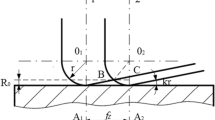Abstract
The aim of this research is to propose the practical model to predict the in-process surface roughness during the ball-end milling process by utilizing the dynamic cutting force ratio. The proposed model is developed based on the experimentally obtained results by employing the exponential function with five factors of the spindle speed, the feed rate, the tool diameter, the depth of cut, and the dynamic cutting force ratio. The experimentally obtained results showed that the frequency of the dynamic cutting force corresponds with the frequency of the surface roughness profile in the frequency domain. Hence, the dimensionless dynamic cutting force ratio is proposed regardless of the cutting conditions to predict the in-process surface roughness by taking the ratio of the area of the dynamic cutting force in X axis to that in Z axis. The multiple regression analysis is adopted to calculate the regression coefficients at 95 % confident level. The experimentally obtained model has been verified by using the new cutting conditions. It is understood that the developed surface roughness model can be used to predict the in-process surface roughness with the high accuracy of 92.82 % for the average surface roughness and 91.54 % for the surface roughness.
















Similar content being viewed by others
References
Benardos, P. G., & Vosniakos, G. C. (2002). Prediction of surface roughness in CNC face milling using neural networks and Taguchi’s design of experiments. Robotics and Computer Integrated Manufacturing, 18, 343–354.
Buj-Corral, I., Vivancos-Calvet, J., & Dominguez Fernandez, A. (2012). Surface topography in ball-end milling processes as a function of feed per tooth and radial depth of cut. International Journal of Machine Tools & Manufacture, 53, 151–159.
Colak, O., Kurbanoglu, C., & Kayacan, M. C. (2007). Milling surface roughness prediction using evolutionary programmimg methods. Materials and Design, 28, 657–666.
Fontaine, M., Moufki, A., Devillez, A., & Dudzinski, D. (2007a). Modeling of cutting forces in ball-end milling with tool-surface inclination part I predictive force model and experimental validation. Journal of Materials Processing Technology, 189, 73–84.
Fontaine, M., Moufki, A., Devillez, A., & Dudzinski, D. (2007b). Modeling of cutting forces in ball-end milling with tool-surface inclination part II influence of cutting condition, run-out, ploughing and inclination angle. Journal of Materials Processing Technology, 189, 85–96.
Huang, P. B. (2014). An intelligent neural-fuzzy model for an in-process surface roughness monitoring system in end milling operations. Journal of Intelligent Manufacturing, Published online: 30 March 2014.
Karunasawat, K., & Tangjitsitcharoen, S. (2012). Surface roughness prediction in ball end milling process for aluminum by using air blow cutting. Advanced Materials Research, 418–420, 1428–1434.
Kovac, P., Rodic, D., Pucovsty, V., Savkovic, B., & Gostinirovic, M. (2013). Application of fuzzy logic and regression analysis for modeling surface roughness in face milling. Journal of Intelligent Manufacturing, 24, 755–762.
Lou, S. J., & Chen, J. C. (1999). In-process surface roughness recognition system in end milling operations. Journal of Advance Manufacturing Technology, 15, 200–209.
Quinsat, Y., Sabourin, L., & Lartigue, C. (2008). Surface topography in ball-end milling process description of a 3D surface roughness parameter. Journal of Materials Processing Technology, 195, 135–143.
Quintana, G., Garcia-Romeu, M. L., & Ciurama, J. (2011). Surface roughness monitoring application based on artificial based on artificial neural networks for ball-end milling operations. Journal of Intelligent Manufacturing, 22, 607–617.
Tangjitsitcharoen, S. (2011a). Advance in detection system to improve the stability and capability of CNC turning process. Journal of Intelligent Manufacturing, 22, 843–852.
Tangjitsitcharoen, S. (2011b). In-process monitoring and prediction of surface roughness in CNC turning process. Advanced Materials Research, 199–200, 1958–1966.
Tangjitsitcharoen, S. (2013). Advanced prediction of surface roughness monitoring of dynamic cutting force in CNC turning process. Applied Mechanics and Materials, 239–240, 661–669.
Tangjitsitcharoen, S., Rungruang, C., & Laiaddee, D. (2010). Mornitoring of dry cutting and applications of cutting fluid for ball-end milling. Industrial Engineering & Management Systems Journal, 9, 242–250.
Tangjitsitcharoen, S., Samanmit, K., & Ratanakuakangwan, S. (2014). Development of surface roughness prediction by utilizing dynamic cutting force ratio. Applied Mechanics and Materials, 490–493, 207–212.
Tangjitsitcharoen, S., & Senjuntichai, A. (2011). Intelligent monitoring and prediction of surface roughness in ball-end milling process. Applied Mechanics and Materials, 121–126, 2059–2063.
Zhang, J. Z., & Chen, J. C. (2007). The development of an in-process surface roughness adaptive control system in end milling operations. Journal of Advance Manufacturing Technology, 31, 877–887.
Zhang, J. Z., Chen, J. C., & Kirby, E. D. (2007). The development of an in-process surface roughness adaptive control system in turning operations. Journal of Intelligent Manufacturing, 18, 301–311.
Acknowledgments
This work was supported by Office of National Research Council of Thailand, Thailand from October 2008 to September 2010.
Author information
Authors and Affiliations
Corresponding author
Rights and permissions
About this article
Cite this article
Tangjitsitcharoen, S., Thesniyom, P. & Ratanakuakangwan, S. Prediction of surface roughness in ball-end milling process by utilizing dynamic cutting force ratio. J Intell Manuf 28, 13–21 (2017). https://doi.org/10.1007/s10845-014-0958-8
Received:
Accepted:
Published:
Issue Date:
DOI: https://doi.org/10.1007/s10845-014-0958-8



